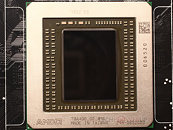Monday, February 9th 2015

Radeon R9 380X Based on "Grenada," a Refined "Hawaii"
AMD's upcoming Radeon R9 380X and R9 380 graphics cards, with which it wants to immediately address the GTX 980 and GTX 970, will be based on a "new" silicon codenamed "Grenada." Built on the 28 nm silicon fab process, Grenada will be a refined variant of "Hawaii," much in the same way as "Curacao" was of "Pitcairn," in the previous generation.
The Grenada silicon will have the same specs as Hawaii - 2,816 GCN stream processors, 176 TMUs, 64 ROPs, and a 512-bit wide GDDR5 memory interface, holding 4 GB memory. Refinements in the silicon over Hawaii could allow AMD to increase clock speeds, to outperform the GTX 980 and GTX 970. We don't expect the chip to be any more energy efficient at its final clocks, than Hawaii. AMD's design focus appears to be performance. AMD could save itself the embarrassment of a loud reference design cooler, by throwing the chip up for quiet custom-design cooling solutions from AIB (add-in board) partners from day-one.In other news, the "Tonga" silicon, which made its debut with the performance-segment Radeon R9 285, could form the foundation of Radeon R9 370 series, consisting of the R9 370X, and the R9 370. Tonga physically features 2,048 stream processors based on the more advanced GCN 1.3 architecture, 128 TMUs, 32 ROPs, and a 384-bit wide GDDR5 memory interface. Both the R9 370 and R9 370X could feature 3 GB of standard memory amount.
The only truly new silicon with the R9 300 series, is "Fiji." This chip will be designed to drive AMD's high-end single- and dual-GPU graphics cards, and will be built to compete with the GM200 silicon from NVIDIA, and the GeForce GTX TITAN-X it will debut with. This chip features 4,096 stream processors based on the GCN 1.3 architecture - double that of "Tonga," 256 TMUs, 128 ROPs, and a 1024-bit wide HBM memory interface, offering 640 GB/s of memory bandwidth. 4 GB could be the standard memory amount. The three cards AMD will carve out of this silicon, are the R9 390, the R9 390X, and the R9 390X2.
Source:
3DCenter.org
The Grenada silicon will have the same specs as Hawaii - 2,816 GCN stream processors, 176 TMUs, 64 ROPs, and a 512-bit wide GDDR5 memory interface, holding 4 GB memory. Refinements in the silicon over Hawaii could allow AMD to increase clock speeds, to outperform the GTX 980 and GTX 970. We don't expect the chip to be any more energy efficient at its final clocks, than Hawaii. AMD's design focus appears to be performance. AMD could save itself the embarrassment of a loud reference design cooler, by throwing the chip up for quiet custom-design cooling solutions from AIB (add-in board) partners from day-one.In other news, the "Tonga" silicon, which made its debut with the performance-segment Radeon R9 285, could form the foundation of Radeon R9 370 series, consisting of the R9 370X, and the R9 370. Tonga physically features 2,048 stream processors based on the more advanced GCN 1.3 architecture, 128 TMUs, 32 ROPs, and a 384-bit wide GDDR5 memory interface. Both the R9 370 and R9 370X could feature 3 GB of standard memory amount.
The only truly new silicon with the R9 300 series, is "Fiji." This chip will be designed to drive AMD's high-end single- and dual-GPU graphics cards, and will be built to compete with the GM200 silicon from NVIDIA, and the GeForce GTX TITAN-X it will debut with. This chip features 4,096 stream processors based on the GCN 1.3 architecture - double that of "Tonga," 256 TMUs, 128 ROPs, and a 1024-bit wide HBM memory interface, offering 640 GB/s of memory bandwidth. 4 GB could be the standard memory amount. The three cards AMD will carve out of this silicon, are the R9 390, the R9 390X, and the R9 390X2.

156 Comments on Radeon R9 380X Based on "Grenada," a Refined "Hawaii"
BL2 is BS anyways 1/2 made frigging game from lazy asses. They just got lucky as they were out of time with the 1st one and people liked it so they pushed more 1/2 done bs and not make what they intended to make in the 1st time.
There's "ass-backwards logic" in here, but it ain't in my posts.
Lets clarify one thing here because I think people don't know definitions:Lets take a quote:That does not make the fact a company developed it turn it into a proprietary software. It's proprietary because it's not open which imposes restrictions. Something is proprietary usually by how much of it you're willing to share. There is no such thing as open source proprietary software, which is what you would get if a company wrote open software by your definition.
For someone with only 7 posts, you've dug yourself a nice little hole for yourself rather quickly on a seemingly stupid topic (the definition of "proprietary").I will agree with this statement unless there are specific rules for either that forbid having both at once.
With that all said, it's entirely possible to have both a proprietary and open source versions of an implemented specification, but doing it doesn't make it proprietary de-facto.